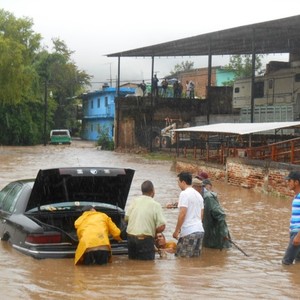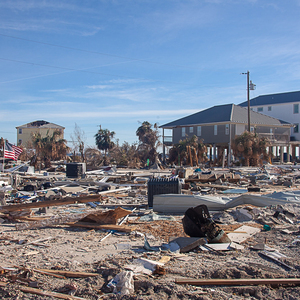
I have a friend living in Panama City, Florida. When Hurricane Michael struck in October of 2018, her house suffered extensive damage—the roof blew off, water ruined ceilings, walls, floors, and flooded ducts in her attic. As of the date I write this, well over a year later, she still struggles to finish fixing her home. She lives in a rented condominium while waiting on contractors to show up and complete repairs. In Houston, Texas, where I sit and write this blog, many still struggle to complete repairs from Hurricane Harvey, which hit the area in late August, 2017, well over two years ago.
The bottleneck in rebuilding comes with a shortage of qualified contractors. Not only does demand for construction work multiply exponentially after a natural disaster, but many local contractors find themselves incapacitated, struggling with damage to their own homes and businesses. The need is acute and immediate, and almost always unmet.
Out-of-town contractors—derisively known as “storm chasers”—will mobilize to help but usually have trouble working in the disaster area legally. States and municipalities put up barriers, fearing fly-by-night opportunists. These barriers come through burdensome state licensing for contractors, local insurance requirements, and business registration. Since it’s a criminal offense to engage in contracting without a valid, local license, storm chasers face may misdemeanor and felony convictions. Only crooks will brave illegality. Legitimate contractors stay home.
A solution to the local logjam could come by way of a national catastrophe license, enabling legitimate and reputable out-of-town contractors to provide relief after a natural disaster.
The CAT license concept
The insurance industry faces an even more significant problem when disaster strikes. State laws impose tight deadlines on how quickly insurance adjuster must respond to homeowner claims. A significant event can result in hundreds of thousands of claims at once. The insurance industry responds by deploying thousands of CAT adjusters, or catastrophe adjusters.
I know his firsthand, as I have worked many storms in this capacity—it’s a good gig. For example, I worked several months in New York City after Hurricane Sandy. New York is a heavily regulated environment, yet I worked legally without a state or local insurance adjuster’s license. Most states have an emergency adjusting license activated after a disaster, which allows an independent adjuster—like me—to obtain this emergency licensing quickly, without passing a state exam or submitting fingerprints. The only requirement is to have a license in another state and attend a day or two of training on local storm policies.

Construction contractors ought to have a similar CAT licensing option enabled by a national body, such as FEMA. One organization lobbying to enact a nationwide emergency contractor’s license is the National Association of Home Builders (NAHB). At the 2019 International Builders’ Show, in Las Vegas, I heard Billy Ward, a 40-year reconstruction veteran from New Orleans, speak passionately about the need to mobilize lawful, out-of-state contractors after a disaster. “Even if all the aid dollars in the world come to the devastated area, recovery does not occur until reconstruction begins,” Ward explained.
During a long career in construction, Ward has personally experienced 14 major storms in his native Louisiana. Hurricane Isaac caused $180,000 damage to Ward’s own residence. So, he has seen natural disaster from all sides, as a homeowner, contractor, and regulator—Ward sits on the Louisiana State Licensing Board for Contractors. He believes the time has come for a national license and registration so that communities can find legitimate, reliable outside help when needed.
I asked Ward, if such licensing went into effect, how outside competition would affect local business. “Not at all,” he replied, recalling 2016, when prolonged rainfall resulted in catastrophic flooding, damaging 110,000 homes in Baton Rouge alone. “There was plenty of work for everyone, and too much for anyone,” Ward said.

By comparison, Ward sees a solution in the recovery method used by electric utilities. “[Utility companies] call linemen from all over the country, who then do what they know how to do. The same goes for debris removal; contractors come from all states and clear the roads quickly.” If utility companies and road departments worked the way housing recovery works, we’d remain without power and roads for years.
An activist in recovery legislation, Ward lobbies state and federal officials to develop efficient and effective recovery plans, including a national license for those that want to work in disaster areas, wherever they occur. Ward set up a nonprofit called Build SOS to gather useful information that can help communities and contractors develop disaster response plans and join him in promoting a national dialog.

As of late, Ward’s lobbying on the NAHB board has resulted in NAHB creating the position of Field Specialist of Disaster Recovery, to administer disaster relief efforts through local chapters. Coincidentally, NAHB’s Home Innovation Research Labs has just been awarded a two-year, $400,000 contract from the US Department of Housing and Urban Development to create guidelines that may help builders and developers incorporate resilience into their projects. Expect this trend to take center stage, as the United Nations has recently published yet another report saying we will not forestall the most damaging effects of climate change.
As Ward points out, code changes for new construction take years to pay off. An efficient and streamlined recovery system—including national licensing to help mobilize the repair industry—would pay off in the very next natural disaster, and this could come in days instead of decades.
What’s in a national license?
Contractors willing and wanting to work nationwide could be required to have ICC Contractor Certification, a basic insurance package, licensing in their home state, and certification through exams for each of the perils—wind, wildfire, earthquake, and flood.
Such preparation and a database of qualified contractors would and should provide an army of emergency responders wherever disaster strikes. Certification, coursework, and licensing would also include a substantial ethical component and civil penalty for those that do not comply with the ethical guidelines.
Who would take charge?
The question of who administers a national licensing program remains the sticking point. Despite advocacy for the concept, NAHB is a membership organization, and not all contractors belong. Ward believes the local chapters could take the lead, without requiring membership. (I doubt the organization would agree).
FEMA seems ideal, although highly bureaucratic. Perhaps we need a new organization, born of consensus between many stakeholders. These stakeholders could include the NAHB, FEMA, the Insurance Institute for Business & Home Safety, the International Code Council, the US Department of Labor’s Employment & Training Administration, and the National Organization of Restoration and Remediation Professionals, to name a few of the possibilities.
As disasters impact communities more frequently and a labor shortage exacerbates recovery, the argument for a streamlined, emergency housing response, like what utilities implement when infrastructure suffers, becomes an urgent priority for our industry. It’s our obligation to the community and an excellent business opportunity to boot.
Epilogue
I asked my friend in Panama City how she’s fairing today, thirteen months’ after the storm. She replies as follows:
Hi Fernando — no work has been done yet except my fence and pool.
I did have a framer come yesterday and they are coming back today so they can get me an estimate for the roof framing and metal roof. Roof is still tarped — had it re-tarped in late August and it is still dry. Been very slow getting estimates for everything.
I received one bid for the framing and roofing of $91,000 — which is utterly ridiculous. Told them no way — I would shrink wrap the roof first before I would pay that amount of money. Lots of price gouging going on.
I am living at the house because I ran out of lodging money at the end of October — so I have a microwave for cooking — thinking about buying a toaster oven and hot plate to cook on — microwave gets old.
Other than that, doing well. Thanks for asking!
Camille
-Fernando Pagés Ruiz is a boutique developer in Colorado and author of two books published by The Taunton Press, “Building an Affordable House: Trade Secrets to High-Value, Low-Cost Construction,” and “Affordable Remodel: How to Get Custom Results on Any Budget.” His latest book, “Architectural Design for Traditional Neighborhoods” will be available in Sep 2019. Photos courtesy of the author.
Weekly Newsletter
Get building science and energy efficiency advice, plus special offers, in your inbox.















4 Comments
This is a solution in search of a problem.
No 1: Licensing itself is not a deterrent for "fly by night" builders. Never has and never will.
No 2: Licensing does not encourage builders to adhere to building codes.
No 3: Building codes are local and climate dependent, therefore builders from out of state are just as likely not to have the required expertise to make an immediate impact.
No 4: Localized supply constraints for building material are also an issue.
No 5: Local and State govts will sometimes add delays as they assess the damage and consequently consider changes to current code or zoning.
"In Houston, Texas, where I sit and write this blog, many still struggle to complete repairs from Hurricane Harvey, which hit the area in late August, 2017, well over THREE years ago."
Check the math on that.................
Yeah....NOT A SOLUTION! THOUSANDS are licensed in my state and CANNOT EVEN READ A TAPE MEASURE....TRUUE STORY!!
Perhaps more qualified building inspectors would be the route to go. Most of these large disaster areas require Wind Storm construction standards.
Those living in such areas pay huge premiums for insurance. Maybe they should expect more from their local communities and insurance company.
Log in or create an account to post a comment.
Sign up Log in